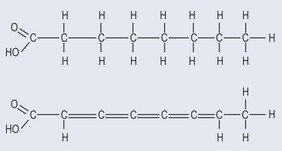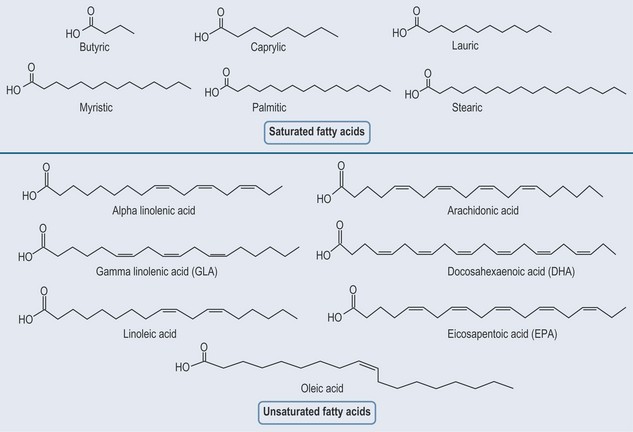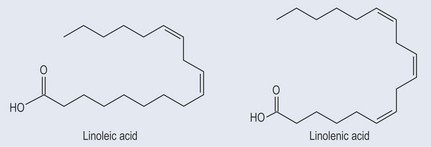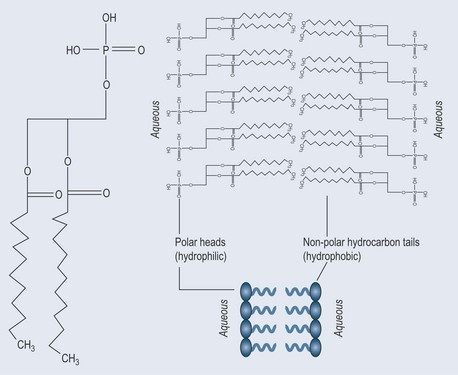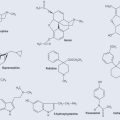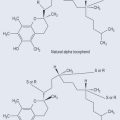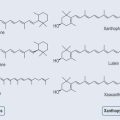Chapter 10 Lipids
 |
These are ultimately derived from fatty acids. |
Lipids have several functions. They are:
Characteristics of Fatty Acids
Unsaturated Fatty Acids
The cis conformations (see Figure 10.2) of the double bonds of unsaturated fatty acids have a bend in their structure of about 30 degrees. This creates significant structural features, particularly for membranes, and as components of membranes the fatty acids tend to have phosphate groups added to them to make phospholipids.
Cis fatty acids can be turned into trans forms by an industrial process. This creates fats with a much higher melting point, which are solid at room temperature and can be made into a spread (e.g. margarines). The natural formation of the bonds has been changed.
• Unsaturated Fatty Acids and the Relevance of its Nomenclature
Oleic acid is designated as 18:1 (Figure 10.4)
This short-hand provides quite a bit of information at a glance to a pharmacist.
Linoleic Acid
Linolenic Fatty Acids
There are two types (see Figure 10.6):
Alpha linolenic acid or all-cis-9,12,15-octadecatrienoic acid:
Gamma linolenic acid or all-cis-6,9,12-octadecatrienoic acid:
Structural Significance of cis Double Bonds
In natural unsaturated fatty acids, the cis bonds cause kinks and make them bend instead of sitting in a straight line (Figure 10.5). The kinking creates a more fluid membrane because the molecules cannot be packed close together, unlike the saturated fatty acids, which can lie in a line. The kinking also ensures that cis unsaturated fatty acids are fluid at room temperature (which is better for areas such as artery walls). Trans fatty acids are problematic because the lipids can lie flat, like a saturated fatty acid, and so cause solid areas of rigid plaque in places like the arteries.
General Information on Fatty Acids
Unsaturated Fatty Acids
• Arachidonic Acid (AA)
• Eicosapentoic Acid (EPA) (Eicosapentaenoic)
• Linoleic Acid
Important Derivatives of Unsaturated Fatty Acids
• Prostanoids
Prostanoids are biologically active lipids, which are synthesized from 20-carbon essential fatty acids or eicosanoids (see eicosapentoic acid, Figure 10.6). There are four main types of eicosanoid:
Their function is discussed in more detail in Chapter 30 (‘Inflammation and the immune system’, p. 228).
Significance of Phospholipids
Membranes tend to be composed of phospholipids, which are lipids attached to a phosphate molecule:
A cell membrane is a bilayer of phospholipids. In other words, two rows of phospholipids are arranged to accommodate the needs of the lipid and phosphate parts of the molecule (Figure 10.7).
Utilizing the Characteristics of Phospholipids
There are ways of getting polar substances through a membrane but these usually involve a mechanism that requires energy; it is not a passive process, and will be covered in more detail later (see Chapter 16 ‘How do drugs get into cells?’, p. 123 and Figure 31.1, p. 236).
Waxes
Waxes (Figure 10.8) are classed as a type of lipid. They are:
Waxes are very non-polar substances, and are therefore water resistant.
Glycolipids
See Chapter 9 (‘Carbohydrates’, p. 72) and Chapter 27 (‘Problems with lipid metabolism’, p. 203). Chylomicrons are large lipoprotein complexes and are synthesized in the cells of the small intestine. They are responsible for transporting lipid from the lumen to other tissues.

